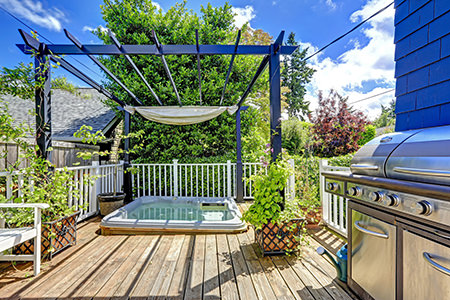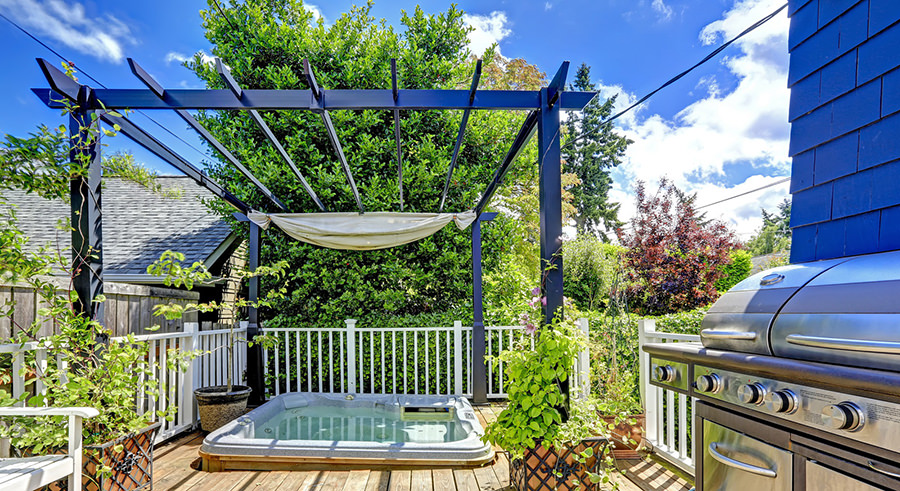
Unless you have a relatively new and high specification hot tub the chances are that you will be able to upgrade your hot tubs insulation. The big advantage of doing this is the potential to save a lot of money on your energy costs. You will also find that your hot tub heats up more quickly and in the long term, the heating components and mechanics of your hot tub will have to to work less hard and will potentially last longer.
But how do you start to add insulation to your hot tub, what is the best sort of insulation to use, how do you apply it and where should you put it? Also how do you actually know that spending all of that time and money on adding insulation to your hot tub will really pay off? I decided to find out and here is what I discovered:
How do I add insulation to my hot tub? The easiest extra insulation to add to your hot tub is a high quality and thermal efficient cover. Also using a floating thermal blanket will make a big difference as will a spa cover cap and a full cover which will help keep out cold draughts. Apart from this, upgrading the insulation inside the hot tub cabinet will also help a lot. This is best done with spray foam insulation or you can insert household fiberglass insulation but this is far less efficient and not very water-resistant.
Why aren’t all hot tubs fully insulated?
You will generally find that if you have a brand new top specification hot tub then it will come with full insulation and will offer a thermal efficiency which is absolutely the best that current technology can offer. However, if you are not in this bracket then the chances are that your hot tub will benefit from the addition of some further insulation.
If you have an older hot tub then it will probably not be particularly well insulated and also if you have a lower priced hot tub you might find that the insulation is not particularly thermally efficient.
Older hot tubs simply were not built with today’s modern thermally efficient materials and techniques. That’s not to say that an older hot tub can’t be extremely pleasurable to use but it will in all probability use a lot more energy than its modern equivalent.
One of the most compelling reasons for buying a new hot tub before your old one is completely worn out is the amount of money that you will save on energy. It’s perfectly reasonable to assume that over a long period of time the amount of money that you will have spent on buying a new more technologically advanced hot tub could well be saved in energy and running costs.
However, if you are not in the market for a new hot tub to replace your old one then upgrading its insulation is a really good step. It will be significantly less expensive than buying a brand new hot tub and will inevitably result in some energy and financial savings.
You will also find that more budget-priced hot tubs have less insulation in them. Insulating a hot tub and making it thermally efficient is relatively expensive and it’s one way that manufacturers at the more budget and mid-range and of the market save money. To a certain extent, one hot tub looks very much like another to a prospective buyer and it’s very easy to forget that the actual real value is inside the cabinet both in the insulation and in the components of the hot tub.
Hot tub manufacturers do tend to rely on the fact that a lower ticket price for a hot tub that still looks fantastic will often get the sale. It’s not until the new hot tub owner has had the hot tub running for a while that they realise that whilst their hot tub may have been a bargain when they bought it, it looks like they’re going to be saddled with ongoing high energy bills. Any hot tub that doesn’t have fantastic insulation will simply cost more to run.
Read more about the different categories and levels of hot tubs in my post How Much Does a Hot Tub Cost to Buy
Whilst I was researching for this article I also read accounts of hot tub manufacturers putting different amounts of insulation into their hot tubs depending upon whereabouts they will be sold. In hotter climates apparently some hot tubs are being sold with less insulation whilst in colder climates, they are being sold with full insulation.
I’m not sure, or at least it wasn’t clear as to whether there is a cost difference to the consumer for the same model with a different amount of insulation purchased in a different area. If you are on the lookout for a new hot tub and live in an area where it is either regularly extremely hot or extremely cold then it would be well worth asking the supplier about the insulation in the hot tub.
So, all hot tubs aren’t insulated the same. You would sort of assume that every hot tub had the maximum amount of insulation in it but unfortunately this is not the case. It depends on the age of the hot tub also the specification and price bracket of the hot tub and also possibly on the area where the hot tub was purchased.

What different types of hot tub insulation are there?
We will have a look at hot tub covers and caps in a moment but first of all, let’s have a think about the actual insulation that’s inside the hot tub cabinet. This is the hidden workings of the hot tub and is where a huge percentage of the heat can either be retained or lost.
Broadly speaking there are two different ways of insulating a hot tub cabinet: partial foam and full foam. You might also find that the inside of a hot tub cabinet has some sort of thermal blanket around it as well. Let’s have a look at partial foam first.
Partial foam hot tub insulation – partial foam insulation was pretty much the standard type of insulation on older types of hot tubs and is still around today in less expensive models. It’s relatively inexpensive to add to a hot tub and so offers some thermal efficiency at a reasonable cost.
Basically, a partial foam hot tub will have foam panels attached to the cabinet sides on the inside. This will help prevent warm air from inside the hot tub from escaping. There is obviously a pocket of warm air between the hot tub shell and the partial foam insulation and cabinet edges.
The disadvantages to partial foam insulation are that it’s not particularly efficient. Cold air can get in through gaps in between the panels and also the foam boards themselves do you become brittle and crack sometimes with age. However, this type of insulation has, and almost still is, the industry standard and you will still find many budget hot tubs use partial foam insulation today.
Sometimes you will also find and that a thermal blanket is used in conjunction with partial foam insulation. This is basically a reflective sheet that surrounds the whole of the hot tub on the inside and the idea is that it reflects heat back into the hot tub. I have read that this offers only very limited amounts of insulation or heat retention and isn’t particularly efficient.
Full foam hot tub insulation – You will find full foam insulation on more modern and particularly on high end hot tubs. Full foam insulation is more expensive than partial foam both in its material cost and also in the techniques to apply it but a full foam hot tub can potentially cost half or less the amount of energy to run than a comparative partial foam hot tub.
In a full foam insulated hot tub foam is sprayed around the hot tub shell and components and essentially fills the gap between the shell and the cabinet edges. Inevitably, this amount of foam provides excellent thermal insulation. It also has the advantage of adding structural strength to the hot tub cabinet as basically everything that could possibly move is safely encased in foam.
This means that in a full foam hot tub there is significantly less vibration from the components which, over a period of many years, leads to less wear and tear and greater longevity and reliability. Also, pipework and joints that are surrounded and supported by foam tend to work loose less frequently so leaks and other similar problems are far less frequent on a full foam hot tub.
However full foam hot tubs do you have have a reputation for being difficult to fix if they do spring a leak. Obviously, it’s really difficult to find where a leak is coming from if it is surrounded by foam. The only way to find a leak and to repair it is to dig out the foam in the leaking area and then to respray it.
Sometimes it’s not obvious where the leak is coming from so working on a full foam hot tub can potentially be much more labour intensive than on a hot tub that doesn’t have full foam insulation. However, full foam hot tubs tend to be built from high-end and reliable components and also, as we saw above, the foam can significantly help to prevent problems.
Bear in mind also that a full foam hot tub will cost significantly less to run in energy costs than a cheaper model so it doesn’t really make sense to worry too much about potential repair problems.
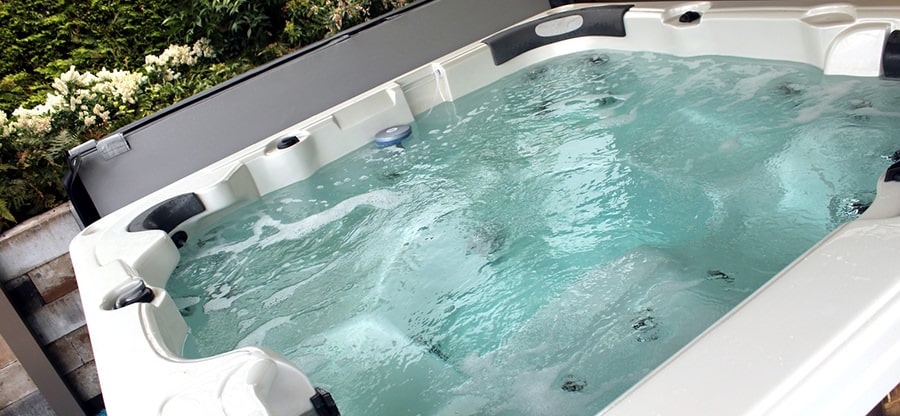
The other problem that full foam hot tubs sometimes have is one of expanding and contracting without causing damage. This is potentially a big problem where most dense and best insulating foam is used.
Some early full foam hot tubs and also some cheaper full foam hot tubs only use one density of foam in order to overcome this problem and it tends to be a less dense and thermally efficient foam than would be ideal. The most current technology and the technology that is used in today’s high-end hot tubs is multi-density foam.
Multi density foam hot tub insulation – In a multi-density foam filled hot tub, foams of several densities are sprayed in different parts of the cabinet to maximize thermal efficiency whilst minimizing the risk of damage due to expansion and contraction. This means that the densest and thermally efficient foams can be taken advantage of in some areas whilst in other areas less dense and more flexible foams are used.
The overall effect is is one of the ultimate thermal efficiency whilst retaining the flexibility to minimize expansion and contraction which could potentially otherwise cause damage to the structure of the hot tub.
How Can I add more insulation to my hot tub?
The chances are that you can probably add some extra insulation to your hot tub and potentially save on your ongoing energy costs quite easily. Not all upgrades to your installation mean that you have to open the cabinet sides and spray foam or insert insulation into awkward places. Some ways of insulating your hot tub are much easier and quicker and will still have a positive effect.
Update your Hot tub cover – It stands to reason that a huge amount of heat will be lost through a hot tub cover if it isn’t particularly efficient or is worn out. Hot air rises and so the hot tub cover really is the first line of defense if you are trying to keep the heat in.
You may well have had a hot tub cover supplied with your hot tub when you bought it. To be honest, in comparison with buying a hot tub with all these jets and lights and exciting features the actual hot tub cover isn’t all that interesting. Hot tub manufacturers are aware of this and will often supply a reasonably good cover with a hot tub but are aware that, at the point of purchase, the quality of the cover is often not at the top of people’s minds.
Therefore you will often find that covers supplied with hot tubs are not as thermally efficient as they could be. Similarly, hot tub covers have a limited amount of useful life. They take a lot of hammering from the steam and vapors that come from the hot tub and also from the elements and all hot tub covers eventually will become waterlogged and significantly less thermally efficient.
If you know that you only have a moderate quality hot tub cover or that your hot tub cover is worn out and due for replacement then don’t hesitate in going out and buying a good quality cover to replace it.
To a certain extent it is a false economy to buy a cheap hot tub cover as over its lifetime it will cost you significantly more in running costs due to the heat escaping from your hot tub than if you had bought a high-quality one in the first place. A high-quality hot tub cover will also probably have a longer useful life than a more budget model.
If you are looking for a new hot tub cover then one of the most important things to look for is the weight or density of the foam actually use used in the thermal barrier. The foam tends to come in 1 lb, 1.5 lb and 2 lb weights. You should buy a hot tub cover with the highest value you can afford – certainly 1.5 as a minimum and preferably 2 in order to get the best form of efficiency. It also stands to reason that is the thicker the foam the more insulation it will provide.
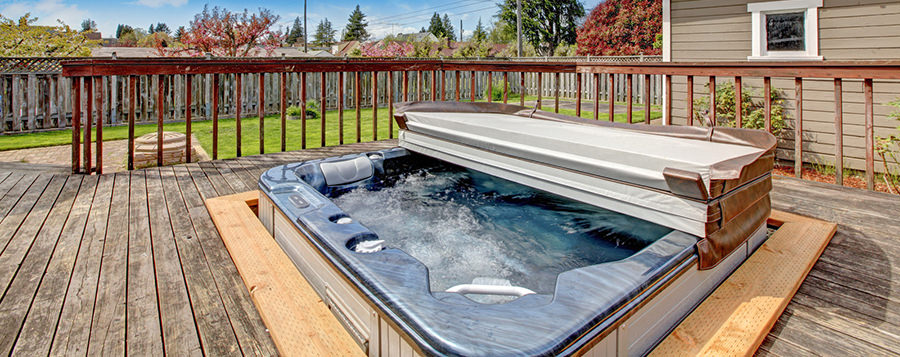
Read much more about buying a hot to cover and caring for it in my post here.
Hot tub thermal blankets – Using a good quality floating thermal blanket when the hot tub isn’t in use will also make a huge difference in terms of insulating the hot tub and saving energy whilst not costing a lot to buy. You need to make sure that you put the floating blanket on top of the hot tub’s water after use every time and then put your cover on over the top.
This hot tub thermal blanket on Amazon also converts solar energy from the sun into heat and so can potentially save you even more money on your energy bills.
Buying a good quality thermal blanket with good thermal insulation properties will make all the difference. Used in conjunction with a good quality cover a thermal blanket will go a long way to saving a lot of potentially escaping heat from the hot tub. As we know heat rises and the hot tub cover and thermal blanket offer a great double defense mechanism in keeping the heat in.
Hot tub caps and full covers – You might also want to consider using a hot tub cap and or even a full cover. Basically, a hot tub cap is a waterproof and windproof jacket that goes over the top part of the hot tub and is strapped on. Most hot tub caps do not have any real insulation properties but they will protect your hot tub cover from the elements and most importantly they will prevent cold air and draughts from getting into the top of your hot tub.
Ultcover are a highly regarded brand and you can see the range on their Amazon page here.
A full cover works in a similar way but obviously covers the whole of the hot tub including the cabinet. This essentially wraps your hot tub in a tarpaulin and again keeps the elements off and most importantly prevents wind and draughts from getting in.
If your hot tub is in a sheltered position or if you live in a warm climate then a hot tub cap or cover may not really be necessary. However, if you are in a climate where there is any regular cold wind or your hot tub is positioned in a space that is prone to getting blown by the wind then a cap or cover would be a good idea.
This is particularly true if you are planning on using your hot tub throughout the winter. Even if you are not going to use your hot tub during the winter season a full cover can be a great idea for keeping the rain, snow and wind out even if the hot tub isn’t in use.
Insulating inside the cabinet – Now onto the big question. Is it actually worth adding more insulation inside the cabinet of your hot tub? This might feel like quite a big task as you will need to take off the sides of the cabinet and be reasonably competent and confident in your DIY skills.
Whether it is worth doing depends on the type of hot tub you have. If you have an older hot tub with minimal insulation then it probably will be worth your time and effort however if you have a new hot tub with some relatively modern insulation in it already then it may be less worthwhile.
There are two main ways of adding insulation to the inside of the cabinet. Firstly you can add Rockwool or household fiberglass insulation and secondly you can spray in foam insulation. The first option is cheaper and simpler. You simply need household insulation and you stuff it into any spaces that you can fit into in the cabinet.
You must be careful to make sure that you do not block any air vents or obstruct any of the components of the hot tub which could potentially need ventilating. It is also a good idea to wrap the insulation in plastic bin bags as it doesn’t do very well if it gets at all wet.
The advantages to this solution are that it is relatively quick, cheap and easy to do and you can also remove the insulation very easily if it causes problems. However, having done a little reading and research on the subject it seems that at using this type of insulation is relatively inefficient. It will make a difference but nowhere near as much as using spray-on foam insulation.
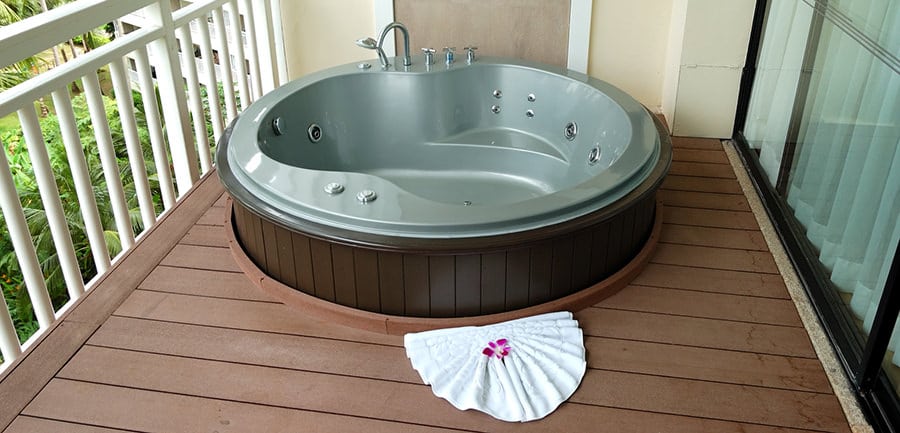
Spray foam insulating your hot tub – Insulating your hot tub with spray foam is a bit more of a complex matter and will also be more expensive. Applying the spray foam requires a bit of skill and you will also need the confidence to apply the foam only in the places where it is safe to do so.
It’s perfectly fine to spray foam all over the outside of the shell and around pipework, jets and joints but you must avoid spraying it components that are likely to get hot or need ventilation such as the heating area or pump. Spray foam is also going to be more expensive than using any other type of foam. Spray foam kits such as this one which are specifically designed for insulating hot tubs start off at around $400.
Bear in mind though that spray foaming your hot tub could potentially cut your energy bill quite substantially. If you use your hot tub all year round and then you would potentially save the cost of the spray foam kit in around a year if you save $10 per week on energy costs.
This is potentially possible as very energy efficient hot tubs can potentially use only $10 worth of energy per week whilst significantly less energy-efficient hot tubs will use up to $30 or $40 of energy per week. Read my post on hot tub running costs here for more information.
Insulating from the ground – Hot tubs can also potentially lose heat if they are not insulated from the ground. If you have ever been camping and either forgotten or rolled off your camp bed or mat during the night you will know how cold the ground feels and how there is a sense of its sucking the heat from you. Your hot tub is the same and if possible should be stood on on insulating material rather than just on the cold ground.
Insulating from the elements – The other thing that can have a big impact on your hot tub is its position. If it is insulated from cold winds by surrounding walls, fences or hedging then it will stay warmer for longer. If it is close to a house or a warmed outbuilding this will also insulate the hot tub from the worst of the cold weather. Similarly, if you can possibly situate your hot tub in a sheltered sunny spot it will keep warm and use less energy in the long term.
Summary
Unless you have a top of the range and relatively new hot tub the chances are that there will be some way that you can improve it’s insulation and thermal efficiency and save money. Generally speaking money spent on insulation is well worth it because in the long term you will recoup it in saved energy expenses. Start by making sure that you have a thermally efficient hot tub cover that is in good working condition. If you add to this a good quality floating thermal blanket then you will relatively cheaply and easily have made a big difference to the insulation properties of your hot tub. Next check whether you can add more insulation in the cabinet and consider the cost and effort option of adding spray foam. Finally, think about the possibility of using a hot tub cap or cover and situating your hot tub in a warm and sheltered spot with insulation under it if possible.
Have you added extra insulation to your hot tub? Has it made a difference and was it worthwhile? It would be great to hear from you, let me know in the comments below.

